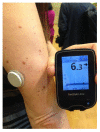An Overview of Insulin Pumps and Glucose Sensors for the Generalist
- PMID: 26742082
- PMCID: PMC4730130
- DOI: 10.3390/jcm5010005
An Overview of Insulin Pumps and Glucose Sensors for the Generalist
Abstract
Continuous subcutaneous insulin, or the insulin pump, has gained popularity and sophistication as a near-physiologic programmable method of insulin delivery that is flexible and lifestyle-friendly. The introduction of continuous monitoring with glucose sensors provides unprecedented access to, and prediction of, a patient's blood glucose levels. Efforts are underway to integrate the two technologies, from "sensor-augmented" and "sensor-driven" pumps to a fully-automated and independent sensing-and-delivery system. Implantable pumps and an early-phase "bionic pancreas" are also in active development. Fine-tuned "pancreas replacement" promises to be one of the many avenues that offers hope for individuals suffering from diabetes. Although endocrinologists and diabetes specialists will continue to maintain expertise in this field, it behooves the primary care physician to have a working knowledge of insulin pumps and sensors to ensure optimal clinical care and decision-making for their patients.
Keywords: diabetes; glucose sensor; insulin pump; monitoring; pancreas.
Figures














References
-
- Diabetes Self Management Insulin Pumps (updated June 20, 2014) [(accessed on 3 November 2015)]. Available online http://www.diabetesselfmanagement.com/diabetes-resources/tools-tech/insu...
-
- David G., Gill M., Gunnarsson C., Shafiroff J., Edelman S. Switching from multiple daily injections to CSII pump therapy: Insulin expenditures in type 2 diabetes. Am. J. Manag. Care. 2014;20:e490–e497. - PubMed
Publication types
LinkOut - more resources
Full Text Sources
Other Literature Sources

